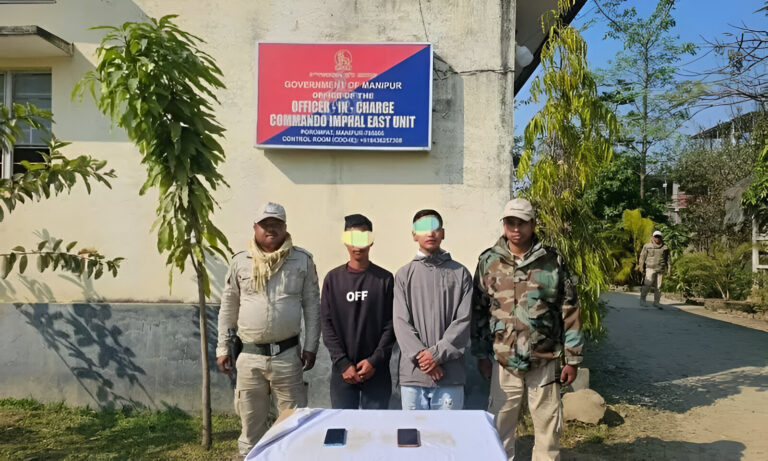Manipur Police Arrest Two Over Viral Video Threatening State Forces: A Major Crackdown on Online Threats
Summary
In a significant move against online threats, Manipur Police have arrested two individuals responsible for a viral video that allegedly threatened state security forces. This incident has raised concerns over the growing misuse of social media for intimidation and violence incitement. The swift action taken by the authorities highlights the state’s zero-tolerance approach towards online threats, reinforcing law enforcement’s commitment to maintaining peace and order.
Introduction
Imagine scrolling through your social media feed and stumbling upon a video openly threatening law enforcement. Shocking, right? In today’s digital world, such incidents are becoming alarmingly frequent, and authorities are now stepping up their game to tackle them.
Manipur recently witnessed one such case when a viral video surfaced online, featuring threats against state security forces. The police wasted no time in tracking down and arresting the individuals behind the video. This development underscores the rising concerns surrounding online threats and their impact on public safety.
But why are such threats becoming more common? And what does this incident mean for the future of law enforcement in the digital age? Let’s break it down and explore the deeper implications of this arrest.
Understanding the Viral Video Incident
What Happened?
It all started when a video began circulating on social media platforms, in which two individuals were seen making direct threats against Manipur’s state forces. Given the current socio-political tensions in the region, such statements were taken very seriously.
Law enforcement authorities quickly swung into action, launching an investigation to identify and apprehend the culprits. Within a short span, the police successfully tracked them down and made the arrests, sending a clear message that such behavior will not be tolerated.
The Role of Social Media in Spreading Misinformation and Threats
Social media is a double-edged sword. While it empowers people with free speech and instant connectivity, it also provides a platform for misinformation, hate speech, and threats.
In recent years, there has been a disturbing trend where individuals and groups use social media to issue threats against law enforcement, political figures, and even civilians. These videos not only create panic but also fuel tensions, sometimes escalating into real-world violence.
The Manipur incident is a textbook example of how dangerous online threats can be. Authorities had to act fast to prevent potential unrest and ensure that such messages do not inspire others to follow suit.
Manipur Police’s Swift Response: A Step Towards Digital Law Enforcement
Tracking Down the Suspects
The police used advanced cyber forensics to trace the origins of the viral video. With the help of digital footprints, social media metadata, and network tracking, the authorities were able to locate and arrest the suspects.
This showcases the growing expertise of law enforcement agencies in tackling cybercrime. Unlike a decade ago, when tracing online threats was more challenging, modern tools have made it easier to track down perpetrators in real-time.
Legal Actions Taken Against the Accused
Once arrested, the two individuals were charged under various sections of the law related to criminal intimidation and cyber offenses. In India, making threats against security personnel is a serious crime, and those found guilty can face heavy fines and imprisonment.
This case serves as a warning to anyone who believes they can hide behind a screen and make reckless statements without consequences. The law is catching up with digital offenders, and authorities are making sure that the internet doesn’t become a breeding ground for criminal activities.
The Growing Threat of Digital Extremism
Why Are Online Threats Increasing?
There are multiple reasons why threats and hate speech on social media are rising:
- Anonymity – Many people feel emboldened to say things online that they wouldn’t dare say in person, believing they won’t be caught.
- Misinformation – Fake news and propaganda often fuel hostility, making people believe that violence or threats are justified.
- Echo Chambers – Social media algorithms often trap users in ideological bubbles, reinforcing their beliefs and pushing them towards radical viewpoints.
- Lack of Regulation – While major platforms have community guidelines, enforcement is often weak, allowing harmful content to spread.
The Impact of Online Threats on Society
Unchecked digital extremism can have severe consequences:
- Increased Violence: Online threats can lead to real-world crimes, as seen in cases of mob lynching or riots triggered by misinformation.
- Erosion of Public Trust: When people see law enforcement being openly threatened, it weakens public confidence in the system.
- Psychological Impact: Constant exposure to violent rhetoric online can normalize aggression, especially among young audiences.
Government and Law Enforcement Measures to Curb Digital Crimes
India’s Cybercrime Laws and Their Implementation
India has several laws in place to tackle cyber threats, including:
- The Information Technology (IT) Act, 2000 – Addresses digital crimes, including online threats, hacking, and cyber terrorism.
- Indian Penal Code (IPC) Sections 503 & 505 – Cover criminal intimidation and statements that incite violence or hatred.
- Unlawful Activities (Prevention) Act (UAPA) – Used in extreme cases to counter digital extremism linked to organized groups.
Steps Taken by Manipur Police
The recent arrests highlight the proactive steps taken by the Manipur police, such as:
- Strengthening cyber monitoring units to track online activities more effectively.
- Collaborating with social media platforms to remove harmful content faster.
- Raising public awareness about the legal consequences of making threats online.
By adopting a tech-savvy approach, law enforcement agencies are ensuring that digital platforms don’t become a playground for criminals.
What This Means for the Future of Law Enforcement
The arrest of these individuals isn’t just about one incident; it signals a larger shift in how police forces handle digital crimes. As technology advances, law enforcement agencies are also evolving, using artificial intelligence, big data analytics, and cyber surveillance to maintain law and order.
But the fight against online threats isn’t just the responsibility of the police. Social media platforms, policymakers, and even everyday users must play a role in ensuring that digital spaces remain safe.
So, what can you do? If you ever come across threatening or violent content online, report it immediately. Your actions could help prevent a major incident and contribute to a safer digital environment.
Conclusion
The arrest of two individuals in Manipur for threatening security forces via a viral video is a landmark case in the fight against digital extremism. It highlights the growing capabilities of law enforcement in tackling cyber threats and reinforces the message that online platforms are not beyond the reach of the law.
With stricter regulations, improved cyber monitoring, and public cooperation, the digital space can be made safer for everyone. This case serves as a powerful reminder that actions have consequences, whether they happen on the streets or behind a screen.
As we move into an increasingly digital future, balancing free speech with responsible online behavior will be crucial in maintaining peace and security.
FAQs
- What charges were filed against the arrested individuals?
They were charged under cybercrime and criminal intimidation laws, which carry severe penalties in India. - How did the police track down the suspects?
Law enforcement used cyber forensics, social media tracking, and digital surveillance to locate and arrest them. - Can social media platforms be held responsible for such incidents?
While platforms have community guidelines, the responsibility to enforce them effectively remains a challenge. Governments are pushing for stricter content regulation. - What should I do if I see a threatening video online?
Report it immediately to the platform and local authorities to prevent potential violence or unrest. - How can law enforcement further improve digital security?
By investing in AI-driven monitoring systems, strengthening cybercrime laws, and collaborating with tech companies for faster threat detection.



